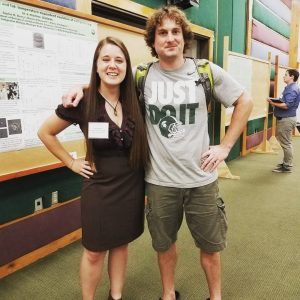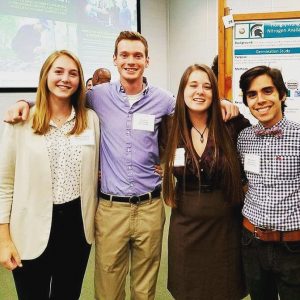How did I get here? This thought rattled through the back of my mind as I performed phosphorus readings on the spectrophotometer.
Me, a paleontologist, working with microscopic algae and being reunited with the machinery that haunted me in general chemistry, a time that seemed prehistoric. The first weeks at KBS felt as though I had been dropped into a different world, one where I was a visitor with an endless number of questions.
This only fostered the fond feelings; this diatom had somehow made me curious to the point of bursting. My mentor, Danny O’Donnell, also had burning questions and my addition seemed like the last piece to the puzzle as our day of rapid-fire speculations produced a project. My love for morphology and Danny’s understanding of this small diatom’s physiology led to a project being made that would marry the two subjects and create a clearer picture of their relationship.
This project we devised was a perfect blend of Danny’s and my fortes—measuring bones was practically a pastime for me at this point. So, when the idea of measuring diatoms floated among the conversations I was certain that this was what I was meant to do here. Danny had been culturing populations of the marine diatom Thalassiosira pseudonana for around 500 generations in cold and hot environments, and observed their population growth rates and collected samples at four assay temperatures, making for a wonderful eco-evolutionary project.
Determining how diatom morphology responds to changes in temperature would tell us how they were taking up nutrients through Danny’s stoichiometry study. In the end, our skillsets meshed well and a project I could be proud of was created, executed, and written up.
My whole past had consisted of trying out projects until I found what I liked, whether that be trapping squirrels in the bushes or measuring bones in a stifling museum in the Dominican Republic. I had lived my life as a series of questions, no answer was ever enough to feed the insatiable need for knowledge. Peers had thought me strange for my love of science and wanting to know more, until I arrived at Kellogg Biological Station.
That different world I mentioned…it’s real. There is a need for more, for knowledge and questions, it is almost palpable when you arrive at KBS. Each person I encountered added kindling to my fire. It was so easy to spread excitement through KBS like a wildfire through the underbrush. From this I gained wonderful friends that shared my feelings and love for science, and for eleven weeks we learned from each other.
The lab wasn’t the only place where we would escape to either, the beauty of KBS was much farther spread than I could’ve imagined. I found that thinking scientifically for too long threatened to burn me out, and luckily Gull Lake provided solace to my singed friends and me. Watching the sunset off the edge of the dock soothed our imposter syndrome, and the questions throttling through our minds were momentarily put to rest.
Between the beauty of the land and the unending support of my peers and mentors it is certain that this summer will live on in my memories. I learned that that stepping out of your comfort zone is crucial for building the tenacious spirit of a scientist. My research in paleontology was comfortable and it had become hard for me to step back and out of that cozy niche I had built.
Stepping back now, I can see the many skills I added to my repertoire, and how much wider my comfort zone has become. For this I want to thank my mentor, Danny O’Donnell, and all the KBS faculty and staff for making my summer a once-in-a-lifetime experience and expanding my love for science one diatom at a time.
Sophia Beery is a senior at Ohio Northern University studying Environmental and Field Biology. She was a 2017 REU (Research Experiences for Undergraduates) student in the Litchman lab.



A legacy of conservation; a commitment to sustainability.
3700 E. Gull Lake Drive
Hickory Corners, MI 49060
(269) 671-5117
info@kbs.msu.edu